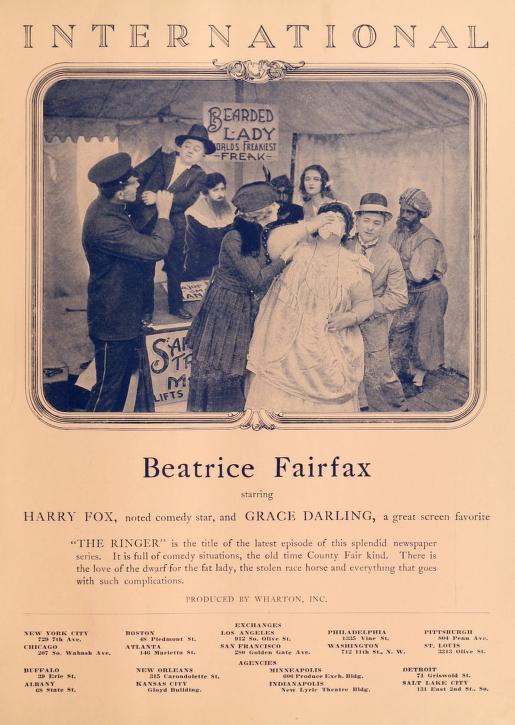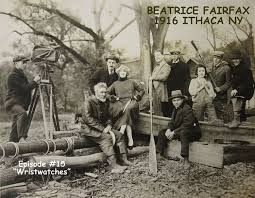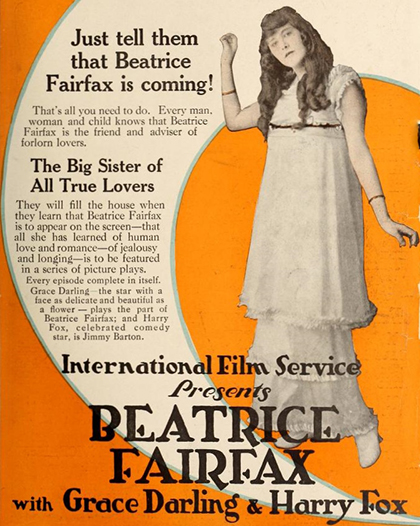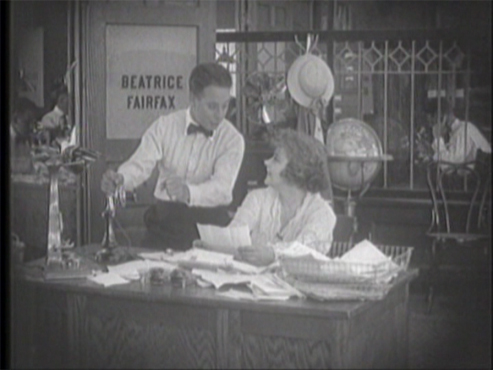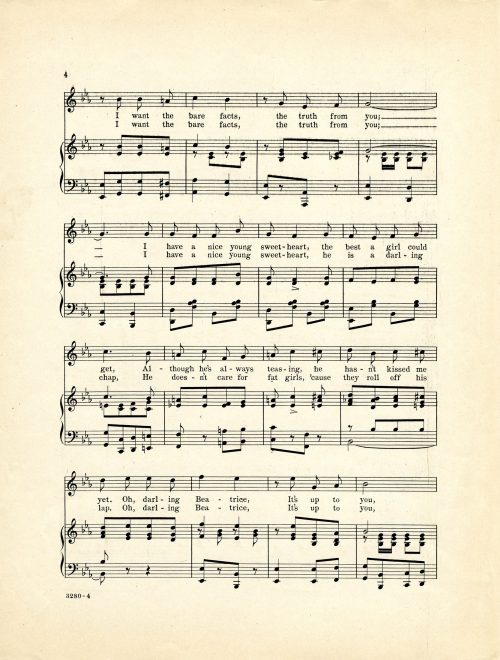B …is for
Beatrice Fairfax
Brothers Theodore and Leopold Wharton were pioneering serial filmmakers who operated their own independent production studio in Ithaca, New York, between 1913 and 1919. After establishing their reputation with their groundbreaking serial The Exploits of Elaine (1914), they cemented it with subsequent serial pictures such as The Mysteries of Myra (1916) and Beatrice Fairfax (1916).
Originally titled Letters to Beatrice, the fifteen-part Beatrice Fairfax capitalized on the trend of real-life female reporters, who, as film scholar Ben Singer writes, became familiar, consistent personalities, much like the era’s ubiquitous “serial queens,” and who sought out new and thrilling experiences in experiential spheres typically out of reach to women. Based on the widely-read “Advice to the Lovelorn” column written by Fairfax and syndicated by newspaper tycoon-turned-movie-producer William Randolph Hearst, the Whartons’ serial reflected the strong collaboration with newspapers that had made the serial genre so popular.
In fact, there was no actual “Beatrice Fairfax.” That was a pseudonym used by Hearst employee Marie Manning, who invented it by combining the name of Dante’s guide Beatrice in The Divine Comedy with the Virginia county of Fairfax, where Manning’s family owned property. Over the next three decades, she and her successors dispensed practical advice to readers who sought the counsel of “Beatrice” on matters from suffrage and sexuality to philandering husbands and interfering in-laws.
The scene of Beatrice Fairfax was set in the prologue of the serial’s first episode (released on August 7, 1916), in which Beatrice outlined her proposition for her milestone column to New York Evening Journal editor Arthur Brisbane (played by Brisbane himself). The subsequent episodes were largely self-contained; and each followed a well-defined pattern, which began with a letter written to Beatrice by one of her trusting readers. Behind each letter was an intriguing event that Beatrice was determined to investigate. The receipt of those letters usually coincided with a story that Beatrice’s beau Jimmy had been assigned to pursue; an admitted amateur sleuth, he was always glad to assist her, often donning one of the costumes he conveniently pulled from a trunk in his apartment or borrowed from others to use as a disguise. Most of the episodes ended with the pair returning to the newsroom to write up the story in time for the paper’s midnight edition.
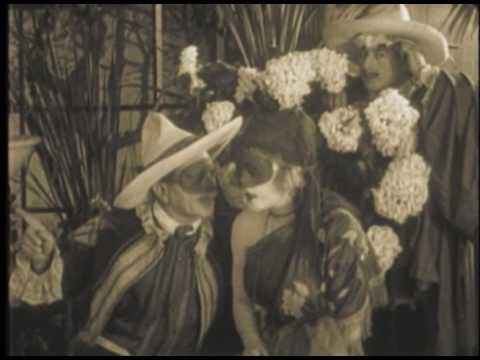
Together, Beatrice (Grace Darling) and Jimmy (Harry Fox) investigate and respond to the letters sent to Beatrice at the New York Evening Journal.
The serial, for which records show the Whartons were paid $4,500 per episode, was said to be “a pet idea” of William Randolph Hearst and therefore received his personal attention and support. The coveted role of Beatrice went to the promising young actress Grace Darling, while her colleague, intrepid reporter Jimmy Barton, was played by Harry Fox, a vaudevillian, dancer, comedian, and actor who gave his name to the popular dance step, the “Fox Trot.” The episodes were co-directed by Robin Townley, a Wharton regular, and James Gordon, another Wharton associate, both of whom also appeared in minor roles in the serial, and by William Bradley. The screenplay was written by Basil Dickey, brother-in-law of serial-picture veteran Charles W. Goddard. Dickey, who wrote for almost one hundred and fifty films over his long career, had already worked with the Whartons on The Romance of Elaine and collaborated with Goddard on several earlier episodes of The Exploits of Elaine.
Apart from the missing first episode, in which Hearst is reputed to have made a cameo appearance, Beatrice Fairfax is the rare silent serial that survives virtually intact. That is largely thanks to Hearst himself. Reportedly, he did not like the picture and intended to remake it with his longtime mistress, Marion Davies, in the lead role. So he gave her the original films to illustrate how they could be improved. Although ultimately the serial was never re-filmed, Davies kept the films as part of her personal collection, which was eventually donated to the Library of Congress.
The most common plot device in the serial, as in advice columns, was love, either unfulfilled or gone awry. Accordingly, the tag line in trade ads was “Beatrice Fairfax: Big Sister of True Lovers.” When Beatrice is not helping young lovers, often she is battling criminals or investigating and exposing political intrigues, as in the episode “Mimosa San,” in which a Japanese government agent conspires to steal plans for a valuable rifle sight. That episode was especially timely since it capitalized on Americans’ fear of the “Yellow Menace,” or “Yellow Peril,” an unfortunate form of xenophobia and racism that had increased after the rise of Chinese immigration in the late nineteenth century.
The influence of Beatrice Fairfax was broad: the serial not only spawned a popular song, “Beatrice Fairfax, Tell Me What To Do,” and a later comic book series. It also initiated a genre of similarly-themed productions set in the newspaper world and helped to pave the way for numerous later “girl reporter” pictures.
Survival Status: Apart from the first episode, the serial is extant in the Library of Congress Marion Davies Collection. Episodes two and four are available on YouTube/Courtesy of Serial Squadron. Link: Beatrice Fairfax, Episode 2: The Adventure of the Jealous Wife (1916). https://www.youtube.com/watch?v=cyjqYpbBoBA.
Directors: Leopold Wharton, Theodore Wharton, with co-directors Robin Townley, James Gordon, William Bradley
Release Date: August 7, 1916
Release Company: Wharton, Inc., for International Film Service
Cast: Grace Darling (Beatrice Fairfax), Jimmy Barton (Harry Fox), Nigel Barrie (Donald Jordan/Bert Kerrigan), Bruce McRae (Bookie), F. W. Stewart (Pete Raven), Robin H. Townley (Blind Man), Bessie Wharton (Madame Laurette/Mrs. Raven/Mrs. Malone), Betty Howe (Margaret Wilson), Mary Cranston (Midge Minturn), M. W. Rale (Shara Ali), Olive Thomas (Rita Malone), James Gordon (Christopher McRay/Prince’s Bodyguard), Yumiko Nagahara (Mimosa San), Chief Buck (Police Chief), Dick Bennard (Conspirator), Evelyn Fariss, May Hopkins, Allan Murnane, Wellington Playter, Elsie Baker, LeRoy Baker, Elaine Hammerstein, Harry Carr, Edgar Davenport, Frank Honda, Warner Oland, Wesley Ruggles, Theodore Tweston, Frances White.
Episodes: (two reels each) 1. The Missing Watchman. 2. The Adventure of the Jealous Wife. 3. Billie’s Romance. 4. The Stone God. 5. Mimosa San. 6. The Forbidden Room. 7. A Name for a Baby. 8. At the Ainsley Ball. 9. Outside the Law. 10. Play Ball. 11. The Wages of Sin. 12. Curiosity. 13. The Ringer. 14. The Hidden Menace. 15. Wrist Watches.

